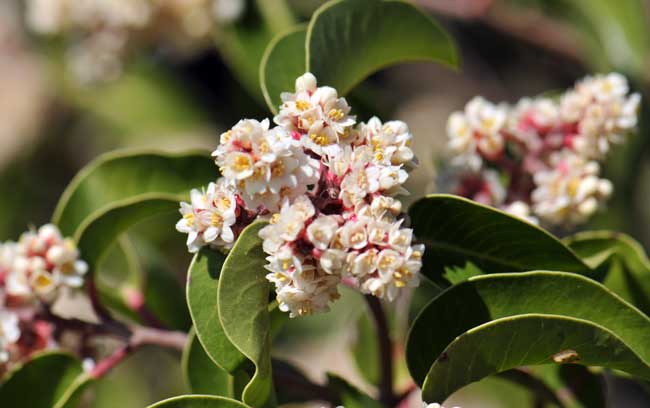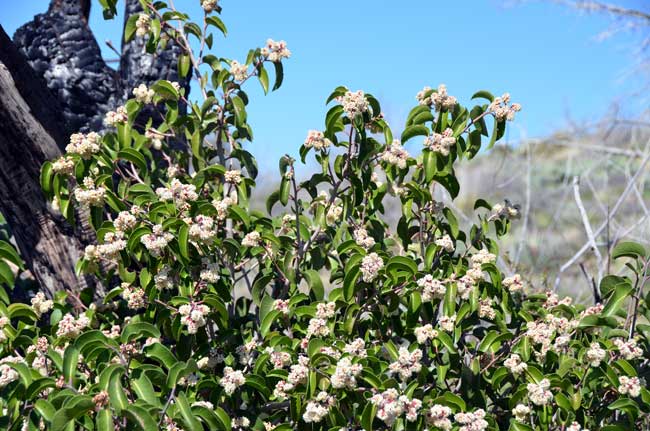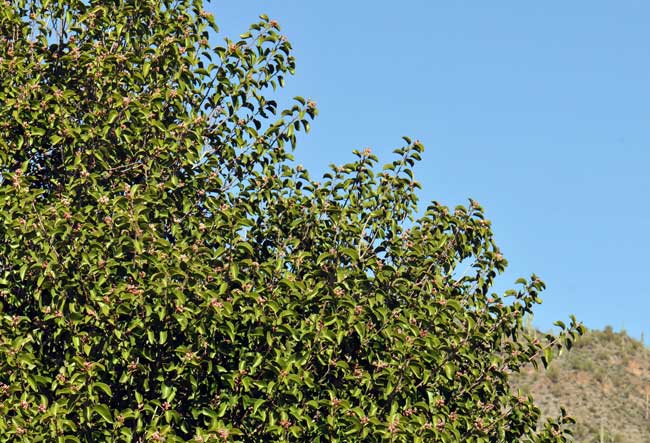Rhus ovata, Sugar Sumac




Scientific Name: Rhus ovata
Common Name: Sugar Sumac
Also Called: Mountain Laurel, Sugar Bush, Sugar-bush (Spanish: Lentisco)
Family: Anacardiaceae, Sumac Family
Synonyms: (Rhus ovata var. traskiae)
Status: Native
Duration: Perennial
Size: 6 to 15 feet (1.8-4.6 m) tall.
Growth Form: Large shrub with rounded appearance or small tree; evergreen, densely leaved, twigs reddish, stout branches, puberulent early then becoming glabrate; old bark shaggy.
Leaves: Bright green; evergreen, shiny, leathery, leaves 1.6 to 3.3 inches (4-8.5 cm) long and 1 to 2 inches (3-5 cm) wide and alternate along the stem or twig; shape variable, heart shaped or ovate; margins entire; glabrous; simple; petiolate; folding at midrib.
Flower Color: Cream, white or pinkish, deep red; inflorescence dense panicles, glabrous; sepals red or magenta; petals cream to pinkish, ciliate; fruit a reddish lenticular-pubescent, sticky (viscid) red berries.
Flowering Season: March to April or later; March to May in California.
Elevation: 1,800 to 6,200 feet (550-1,900 m); below 4,000 feet (1,220 m) in California.
Habitat Preferences: Mid to upper edge of Sonoran Desert, canyons, rocky hillsides, along washes, south-facing slopes and mesas, common in chaparral.
Recorded Range: Rare in the United States found in southern California and central and northwest Arizona. Also found in Baja California.
North America & US County Distribution Map for Rhus ovata.
U.S. Weed Information: No data available.
Invasive/Noxious Weed Information: No data available.
Wetland Indicator: No data available.
Threatened/Endangered Information: No data available.
In the Southwestern United States: Arizona and Texas each have 7 species of genus, California has 5 species, Nevada has 2 species, New Mexico has 5 species and Utah has 3 species. All data approximate and subject to revision.
Comments: Sugar Sumac is an attractive plant often used as an ornamental and desert landscape specimen in central and southern Arizona and southern California.
In California, Sugar Sumac is similar in appearance to, and known to hybridize with, Lemonade Sumac, Rhus integrifolia.
In Southwest Desert Flora also see; Kearney's Sumac, Rhus kearneyi, Littleleaf Sumac, Rhus microphylla and Skunkbush Sumac, Rhus trilobata var. trilobata and Smooth Sumac, Rhus glabra.
Rhus ovata has been used for food and other purposes American indigenous peoples.
Cahuilla Drug, Cold Remedy, Infusion of leaves taken for colds.
Cahuilla Food, Dried Food, Berries dried.
Cahuilla Food, Porridge, Berries ground into a flour for mush.
Coahuilla Drug, Analgesic, Infusion of leaves taken for chest pain.
Diegueno Drug, Gynecological Aid, Infusion of leaves taken just before the birth for an easy delivery.
Yavapai Food, Fruit, Mashed, raw berries used for food.
See other ethno-botanical uses at Native American Ethnobotany, University of Michigan, Dearborn.

